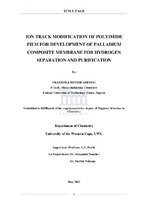| dc.description.abstract | South Africa s coal and platinum mineral resources are crucial resources towards creating an alternative and environmentally sustainable energy system. The beneficiation of these natural resources can help to enhance a sustainable and effective clean energy base infrastructure and further promote their exploration and exportation for economics gains. By diversification of these resources, coal and the platinum group metals (PGMs) especially palladium market can be further harnessed in the foreseeable future hence SA energy security can be guaranteed from the technological point of view. The South Africa power industry is a critical sector, and has served as a major platform in the South African socio-economic development. This sector has also been identified as a route towards an independent energy base, with global relevance through the development of membrane technologies to effectively and economically separate and purify hydrogen from the gas mixtures released during coal gasification. The South Africa power industry is a critical sector, and has served as a major platform in the SA's socio-economic development. This sector has also been identified as a route towards an independent energy base, with global relevance through the development of membrane technologies to effectively and economically separate and purify hydrogen from the gas mixtures released during coal gasification. Coal gasification is considered as a source of hydrogen gas and the effluent gases released during this process include hydrogen sulphide, oxides of carbon and nitrogen, hydrogen and other particulates. In developing an alternative hydrogen gas separating method, composite membrane based on organic-inorganic system is being considered since the other available methods of hydrogen separation are relatively expensive. The scientific approach of this study involves the use of palladium modified
polyimide composite membrane. Palladium metal serves as hydrogen sorption material, deposited on polyimide substrates (composite film) by electroless technique. Polyimide is a class of polymer with excellent physico-chemical properties such as good mechanical strength, superior thermal stability and high resistance to chemical attack. In this study, a composite polymer-palladium
membrane was developed and investigated to determine the prospect of using this membrane as a cheap, accessible, reliable and efficient system to separate and purify hydrogen gas. Prior to the palladium metal plating, the challenge of metal adhesion on glassy polymer such as polyimide film was addressed by chemical etching and unirradiated and irradiated polyimide film surface using NaOH, NaOCl and a mixture of NaOH/NaOCl solutions. The time of etching was varied and the overall effect of this surface
treatment was deeply investigated using Fourier transform infrared (FTIR) spectroscopy. The FTIR study focused on the structural deformation of the polyimide functional group units and the emergence of ‘active sites’ along the polyimide backbone structures that have been identified to allow the Pd metal exchange on the functionalised polyimide film. The detailed use of FTIR spectroscopic technique in this study on the etched unirradiated and irradiated polyimide film was to understand the chemical interaction between the polyimide functional group units and the chemical etchants. The surface morphology of unirradiated and irradiated polyimide samples was studied using SEM, the depth profile (penetration) of palladium particles after electroless deposition on the polyimide matrix was investigated by SEM and TEM analysis. As for the alkaline etched irradiated polyimide, pore distribution, shape and size depended on the etching time and solution. In the XRD analysis, the palladium modified unirradiated polyimide film indicated the diffraction peaks of palladium metal in the (1,1,1), (2,2,0) and (2,0,0) planes present in the polyimide surface, and the peel test showed that the strength of adhesion of palladium on unirradiated surface was low compared to the palladium modified irradiated polyimide. The NaOH solution showed the best etchant at 20 minutes for the unirradiated palladium modified polyimide. The hallmark of this study was the design, fabrication and assemblage of home-built hydrogen diffusion reactor unit used to measure rate of hydrogen diffusion property of unirradiated and irradiated polyimide films from 25 °C to 325 °C. The rate of hydrogen diffusion was observed to depend on the etching time of polyimide surface
before and after the polyimide surface irradiation treatment. | en_US |

